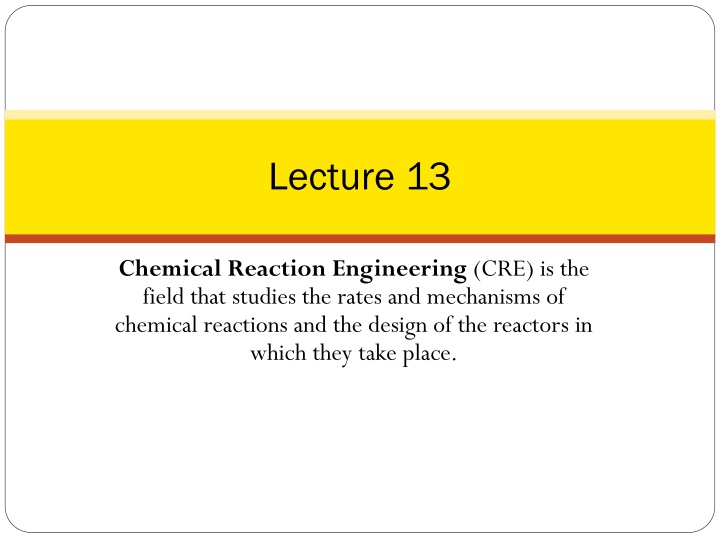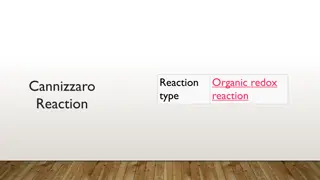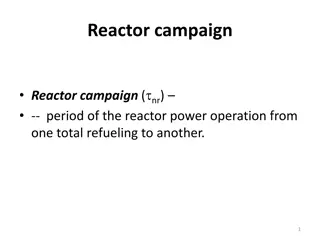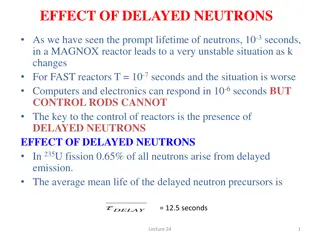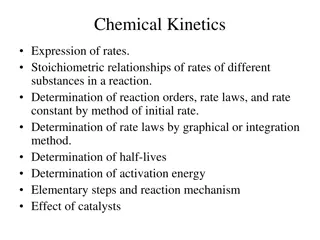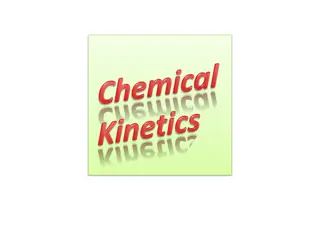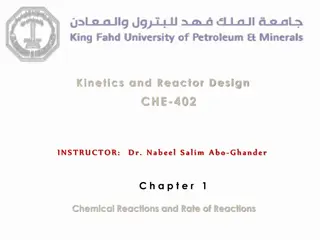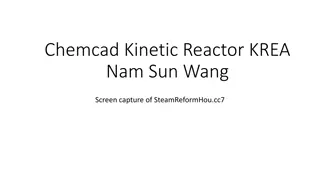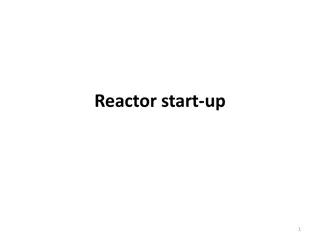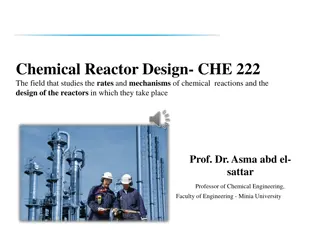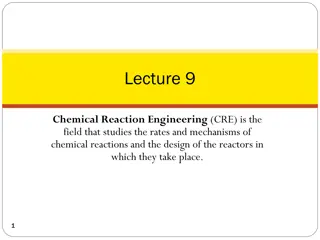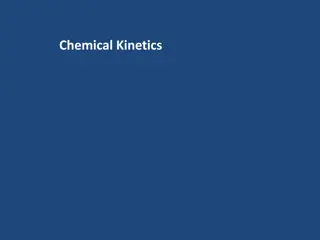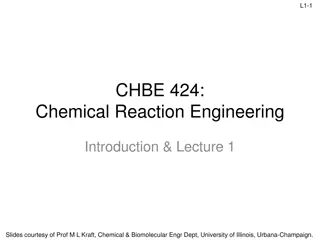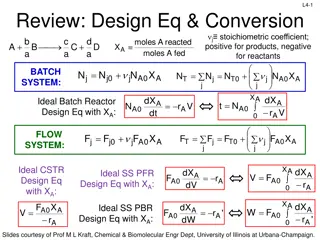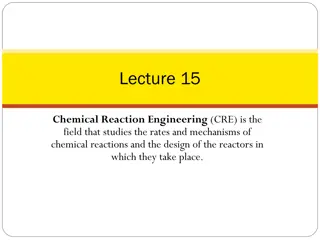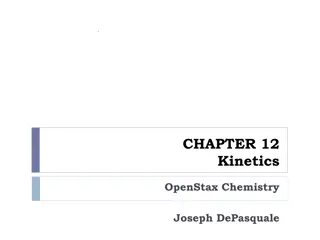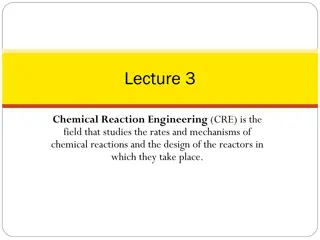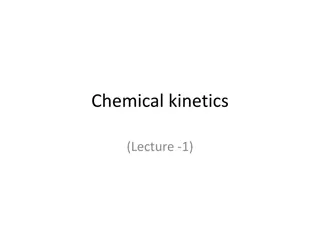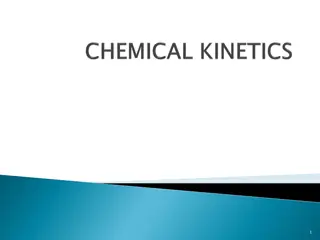Chemical Reaction Engineering: Rates, Mechanisms, and Reactor Design
Chemical Reaction Engineering (CRE) delves into the study of rates, mechanisms, and the design of reactors for chemical reactions. Explore complex reactions in liquid and gas phases, multiple reactions, reactor mole balance summaries, and stoichiometry concentrations. Understand the nuances of batch flow, reactor types, and more.
Download Presentation

Please find below an Image/Link to download the presentation.
The content on the website is provided AS IS for your information and personal use only. It may not be sold, licensed, or shared on other websites without obtaining consent from the author.If you encounter any issues during the download, it is possible that the publisher has removed the file from their server.
You are allowed to download the files provided on this website for personal or commercial use, subject to the condition that they are used lawfully. All files are the property of their respective owners.
The content on the website is provided AS IS for your information and personal use only. It may not be sold, licensed, or shared on other websites without obtaining consent from the author.
E N D
Presentation Transcript
Lecture 13 Chemical Reaction Engineering (CRE) is the field that studies the rates and mechanisms of chemical reactions and the design of the reactors in which they take place.
Lecture 13 Lecture 13 Tuesday 2/26/2013 Tuesday 2/26/2013 Complex Reactions: A +2B C A + 3C D Example A: Liquid Phase PFR Example B: Liquid Phase CSTR Example C: Gas Phase PFR Example D: Gas Phase Membrane Reactors Sweep Gas Concentration Essentially Zero Sweep Gas Concentration Increases with Distance Example E: Semibatch Reactor 2 2
Gas Phase Multiple Reactions 3 3
New things for multiple reactions are: New things for multiple reactions are: 1. Number Every Reaction 2. Mole Balance on every species 3. Rate Laws (a) Net Rates of Reaction for every species = i 1 N = r r A iA (b) Rate Laws for every reaction C k r = = 2 B C 1 1 A A A (c) Relative Rates of Reaction for every reaction For a given reaction i: (i) aiA+biB ciC+diD: r b a 2 A 3 C r k C C 2 2 C C r r r = = = iA iB iC c iD d 4 4 i i i i
Reactor Mole Balance Summary Liquid Phase Reactor Type Gas Phase dN dC Batch A= = r V A A r A dt dt C dC dN Semibatch = A= 0 A A r r V A A dt V dt dN C C dC = + B r V F = + 0 0 B B B r 0 B B B dt dt V 5 5
Reactor Mole Balance Summary Liquid Phase Reactor Type Gas Phase ( ) C C F F CSTR = = 0 A A V 0 A A V 0 r r A A dC dF PFR = = A r A r 0 A A dV dV dF dC A A = = A r A r PBR 0 dW dW Note: The reaction rates in the above mole balances are net rates. 6 6
Batch Flow N F B= C = B B C B V P T P T N F = = 0 0 0 0 T T V V 0 0 N P T F P T 0 0 T N T F T T N P F P = = 0 0 0 0 T T B B C C B B N V P T F P T 0 0 0 0 T T T T N P F P = = 0 0 B B C C C C 0 0 B T B T N P T F P T 0 0 T T 7
Stoichiometry Concentration of Gas: pT0 FA FT CA=CT0 FT= FA+FB+FC+FD T Note: We could use the gas phase mole balances for liquids and then just express the concentration as: F C = A Flow: A 0 N A= Batch: A C 0 V 8 8
Example A: Liquid Phase PFR The complex liquid phase reactions follow elementary rate laws: r = 2 B + k C C ) 1 ( 2 A B C 1 1 A A A NOTE: The specific reaction rate k1A is defined with respect to species A. + ) 2 ( 3 2 C A D = 3 C 2 A r k C C 2 2 C C NOTE: The specific reaction rate k2C is defined with respect to species C. 9 9
Example A: Liquid Phase PFR Complex Reactions A+2B C (1) (2) A+ 3C D 1) Mole Balance on each and every species dF dF = = ) 1 ( ) 2 ( A B r r A B dV dV dF dF = = ) 3 ( ) 4 ( C D r r C D dV dV 10 10
Example A: Liquid Phase PFR 2) Rate Laws: Net Rates A r ) 6 ( = + = + ) 5 ( ) 7 ( r r r r r 0 r 1 2 1 2 A A B B + B = + = ) 8 ( r r r r 1 2 2 C C C D D = 2 B Rate Laws ) 9 ( r k C C 1 1 A A A = 2 A 3 C 10 ( ) r k C C 2 2 C C r r r Relative Rates Reaction 1 = = 1 1 C 1 1 A B 1 2 = = (11) (12) 2 r r r 1 1 r B A 1 1 C A 11 11
Example A: Liquid Phase PFR r r r Relative Rates Reaction 2 = = 2 2 2 C A D 2 3 1 2 = 13 ( ) r r 2 2 A C 3 r = 2 14 ( ) C r 2 D 3 2 = 2 B 2 A 3 C r k C C k C C 1 2 A A A C 3 = 2 B 2 r k C C 1 B A A = 2 A 3 C r k C C k C C 1 2 C A A B C k = 2 A 3 C 2 3 C r C C 12 12 D
Example A: Liquid Phase PFR 3) Stoichiometry Liquid 15 ( = ) C F 0 A A = 16 ( ) C F 0 B B = 17 ( ) C F 0 C C = 18 ( ) C F 0 D D ~ S F ( ) else = 19 ( ) 00001 . 0 then 0 C if V C D F D 13 13
Example A: Liquid Phase PFR = T F Liquid = C k Not Needed Others 19 ( ) Liquid 0= = Not Needed ( ( 20 21 ) ) Liquid 10 = Not Needed T 4) Parameters 1 A ( 22 ) 20 k 2 C C Liquid = ( 23 ) Liquid = ( 24 ) 0 T = ( 25 ) 2500 = V f ( 26 ) 200 F 0 A = ( 28 ) 200 F 0 = B 14 14 ( 26 ) 100 0
Example B: Liquid Phase CSTR Same reactions, rate laws, and rate constants as Example A 2 ) 1 ( C B A + r = 2 B k C C 1 1 A A A NOTE: The specific reaction rate k1A is defined with respect to species A. + ) 2 ( 3 2 C A D = 3 C 2 A r k C C 2 2 C C NOTE: The specific reaction rate k2C is defined with respect to species C. 15 15
Example B: Liquid Phase CSTR The complex liquid phase reactions take place in a 2,500 dm3 CSTR. The feed is equal molar in A and B with FA0=200 mol/min, the volumetric flow rate is 100 dm3/min and the reaction volume is 50 dm3. Find the concentrations of A, B, C and D existing in the reactor along with the existing selectivity. Plot FA, FB, FC, FD and SC/D as a function of V 16 16
Example B: Liquid Phase CSTR (1) A + 2B C (2) 2A + 3C D = 2 B r k C C 1 1 A A A = 2 A 3 C r k C C 2 2 C C 1) Mole Balance + = ) 1 ( 0 A C C r V A 0 0 0 A A + = ) 2 ( 0 B C C r V 0 0 0 B B B + = ) 3 ( 0 0 C C r V 0 C C + = ) 4 ( 0 0 D C r V 0 D D 17 17
Example B: Liquid Phase CSTR 2) Rate Laws: (5)-(14) same as PFR 3) Stoichiometry: (15)-(18) same as Liquid Phase PFR F C = = 0 19 ( ) C C S / C D 0001 . 0 + 0001 . 0 + F C 0 D D 4) Parameters: , , , , , k k C C V 1 2 0 0 0 A C A B 18 18
Example B: Liquid Phase CSTR In terms of molar flow rates (1) A + 2B C r (2) 2A + 3C D = 2 B k C C 1 1 A A A = 2 A 3 C r k C C 2 2 C C 1) Mole Balance (1 4) 2) Rates (5 14) 3) Stoichiometry: (15 19) ( ( ) ) Same as Example A = + = (=0) ) 1 ( f F F F r V A 15 ( ) C F 0 A A 0 A A A = 16 ( ) C F = + 0 B B ) 2 ( f F F F r V (=0) 0 B B B B = 17 ( ) C F 0 C C ( ) = = 0 + 18 ( ) C F ) 3 ( f F F r V (=0) 0 D D C C C F = 19 ( ) C S ( ) C D + . 0 00001 = 0 + F ) 4 ( f F F r V (=0) D D D D 19 19
Example B: Liquid Phase CSTR In terms of concentration (1) A + 2B C r (2) 2A + 3C D = 2 B k C C 1 1 A A A = 2 A 3 C r k C C 2 2 C C 1) Mole Balance (1 4) ( ) C C f A A = 0 0 ) 1 ( 2) Rates (5 14) 3) Stoichiometry: (15 19) (=0) + C r V A Same as Example A F 0 A = 15 ( ) C S C D 00001 . 0 + F D ( ) (=0) = + ) 2 ( f C C C r V 0 0 0 B B B B ( ) (=0) = + ) 3 ( 0 f C C r V 0 C C C ( ) = + (=0) ) 4 ( 0 f C C r V 0 D D D 20 20
Example C: Gas Phase PFR, No P Same reactions, rate laws, and rate constants as Example A: + ) 1 ( NOTE: The specific reaction rate k1A is defined with respect to species A. + 2 A B C r = 2 B k C C 1 1 A A A ) 2 ( 3 2 C A D = 3 C 2 A r k C C 2 2 C C NOTE: The specific reaction rate k2C is defined with respect to species C. 21 21
Example C: Gas Phase PFR, No P 1) Mole Balance dF dF = = ) 1 ( ) 3 ( C A r r A C dV dV dF dF = = (2) ) 4 ( B D r r B D dV dV 2) Rate Laws: (5)-(14) same as CSTR 22 22
Example C: Gas Phase PFR, No P 3) Stoichiometry: Gas: Isothermal T = T0 (15) CA=CT0 FA FT FC FT FB FT FD FT (16) CB=CT0 p p (17) CC=CT0 (18) CD=CT0 p p (19) FT= FA+FB+FC+FD Packed Bed with Pressure Drop dp dW=-a =-a FT FT0 T FT FT0 2p 2p T0 23 23
Example C: Gas Phase PFR, No P 4) Selectivity F F ( ) ( ) ( ) 0 else = = if 00001 . 0 then 20 C C S V F F D D ( ) p=1 21 24 24
Example D: Membrane Reactor with P Same reactions, rate laws, and rate constants as Example A: 2 ) 1 ( C B A + r = 2 B k C C 1 1 A A A NOTE: The specific reaction rate k1A is defined with respect to species A. + ) 2 ( 3 2 C A D = 3 C 2 A r k C C 2 2 C C NOTE: The specific reaction rate k2C is defined with respect to species C. 25 25
Example D: Membrane Reactor with P Because the smallest molecule, and the one with the lowest molecular weight, is the one diffusing out, we will neglect the changes in the mass flow rate down the reactor and will take as first approximation: 1) Mole Balances dF A = m = 0 m dF ( ) 1 ( ) 3 = C A r C r R A C C dV dV dF dF ( ) 2 ( ) 4 = = B B D r D r B D dV dV We also need to account for the molar rate of desired product C leaving in the sweep gas FCsg dF Csg = R C dV 26 26
Example D: Membrane Reactor with P We need to reconsider our pressure drop equation. When mass diffuses out of a membrane reactor there will be a decrease in the superficial mass flow rate, G. To account for this decrease when calculating our pressure drop parameter, we will take the ratio of the superficial mass velocity at any point in the reactor to the superficial mass velocity at the entrance to the reactor. = = G 0 F MW G i i 0 0 F MW 0 i i 27
Example D: Membrane Reactor with P The superficial mass flow rates can be obtained by multiplying the species molar flow rates, Fi, by their respective molecular weights, summing over all species: Mwi, and then ( ( ) ) ( ( 0 ) ) m A F MW A F MW G C i i C i i = = = 1 1 G m A F MW A F MW 0 0 0 C i i C i i 1 1 28 28
Example D: Membrane Reactor with P 2) Rate Laws: (5)-(14) same as Examples A, B, and C. 3) Stoichiometry: (15)-(20) same as Examples A and B (T=T0) dp dW=-a 2p FT0 dV=-ra FT dp FT FT0 21 ( ) 2p ( ) = R k C CSweep C C C C 4) Sweep Gas Balance: + = 0 F F R V Csg Csg C + V V V dF Csg = R C 29 29 dV
Example E: Liquid Phase Semibatch Semibatch Same reactions, rate laws, and rate constants as Example A: + ) 1 ( 2 A B C r = 2 B k C C 1 1 A A A NOTE: The specific reaction rate k1A is defined with respect to species A. 2 3 ) 2 ( D A C + = 3 C 2 A r k C C 2 2 C C NOTE: The specific reaction rate k2C is defined with respect to species C. 30 30
Example E: Liquid Phase Semibatch Semibatch The complex liquid phase reactions take place in a semibatch reactor where A is fed to B with FA0= 3 mol/min. The volumetric flow rate is 10 dm3/min and the initial reactor volume is 1,000 dm3. The maximum volume is 2,000 dm3 and CA0=0.3 mol/dm3 and CB0=0.2 mol/dm3. Plot CA, CB, CC, CD and SS/D as a function of time. 31 31
Example E: Liquid Phase Semibatch Semibatch FA0 (1) A + 2B C (2) 2A + 3C D 1) Mole Balances: B dN = + A r V F 0= 0 N 0 A A dt A dN B= r V = = . 2 000 N C V B 0 0 0 B B dt dN C= r V 0= 0 N C C dt dN D= r V 0= 0 N D D dt 32
Example E: Liquid Phase Semibatch Semibatch 2) Rate Laws: (5)-(14) Net Rate, Rate Laws and relative rate are the same as Liquid and Gas Phase PFR and Liquid Phase CSTR ( ) 15 = + V V v t 0 N 0 N ( ) 16 ( ) 17 = = A B C C A B V V N N ( ) 18 ( ) 19 = = C D C C C D V V 3) Selectivity and Parameters: N ( ) 20 else F0 = if ( 0001 . 0 then ) ) 0 ( C S t / C D N D A= V = 3 mol min 0= 3 3 100 dm 10 dm min 33 0
End of Lecture 13 End of Lecture 13 34 34
